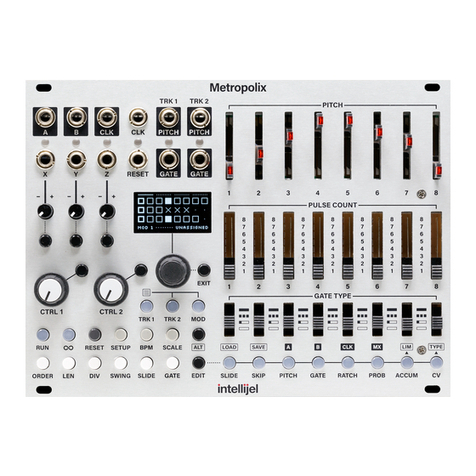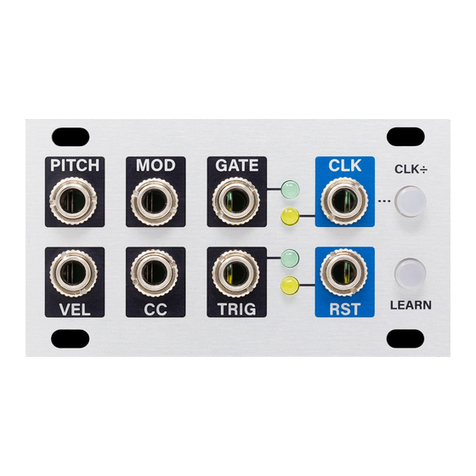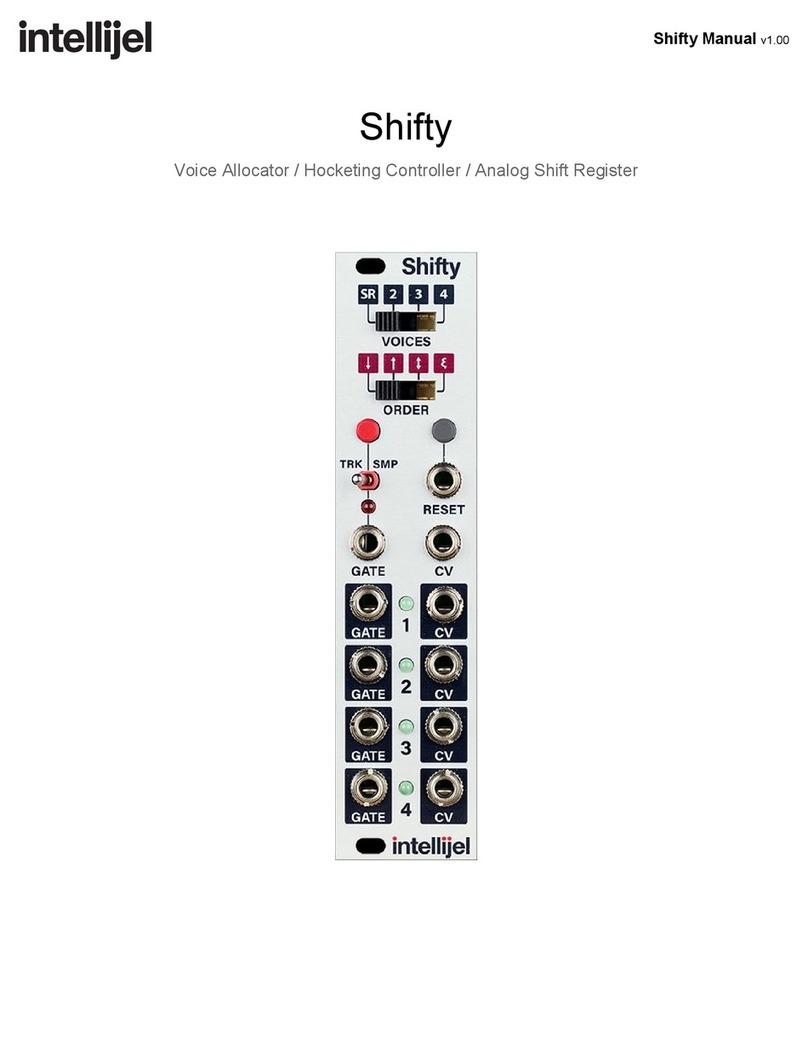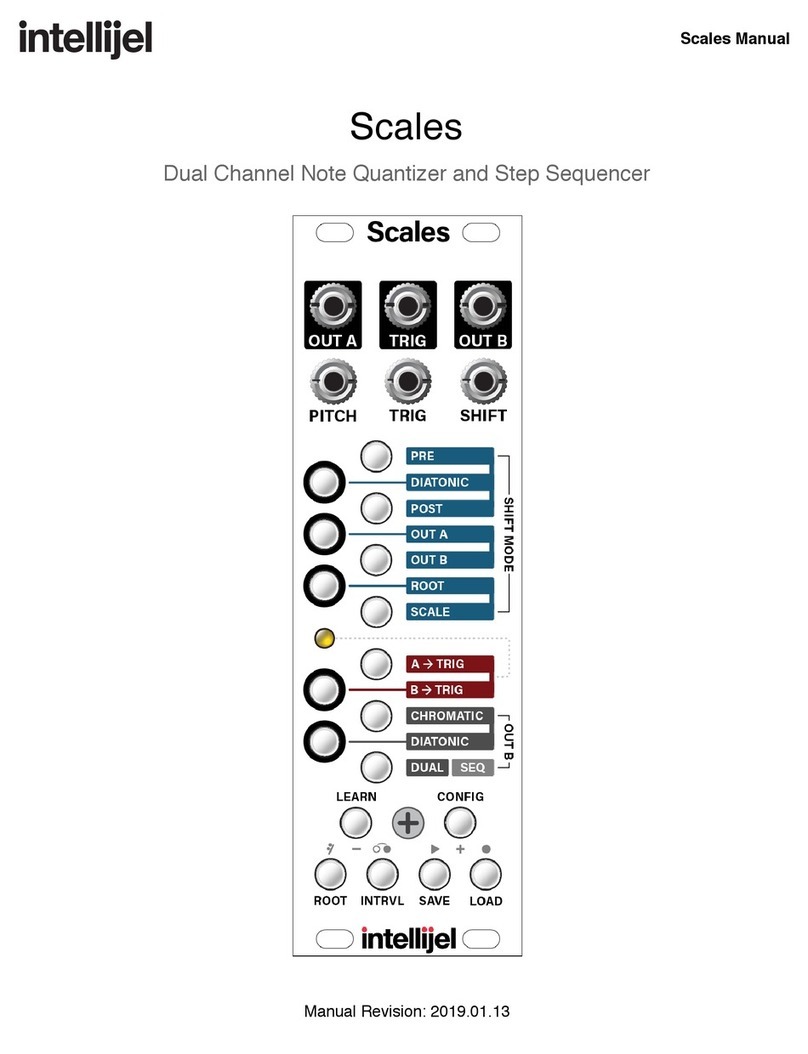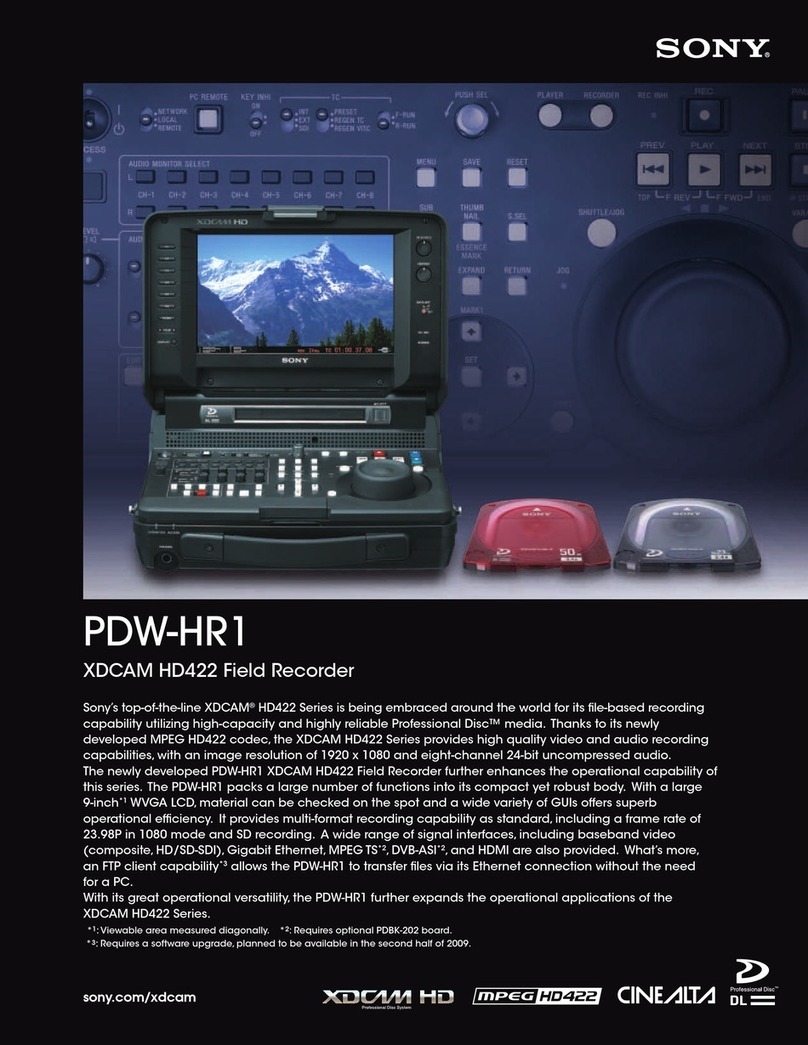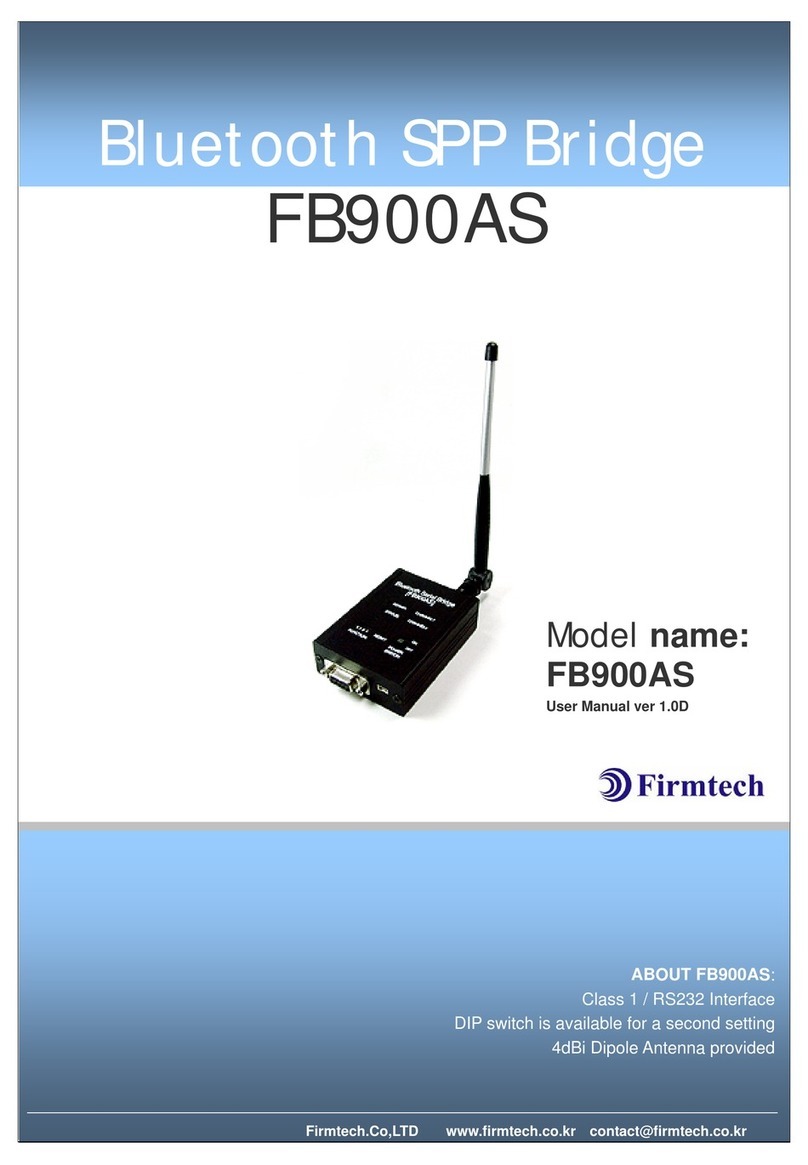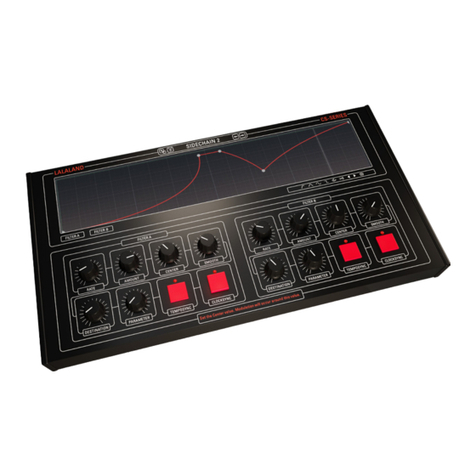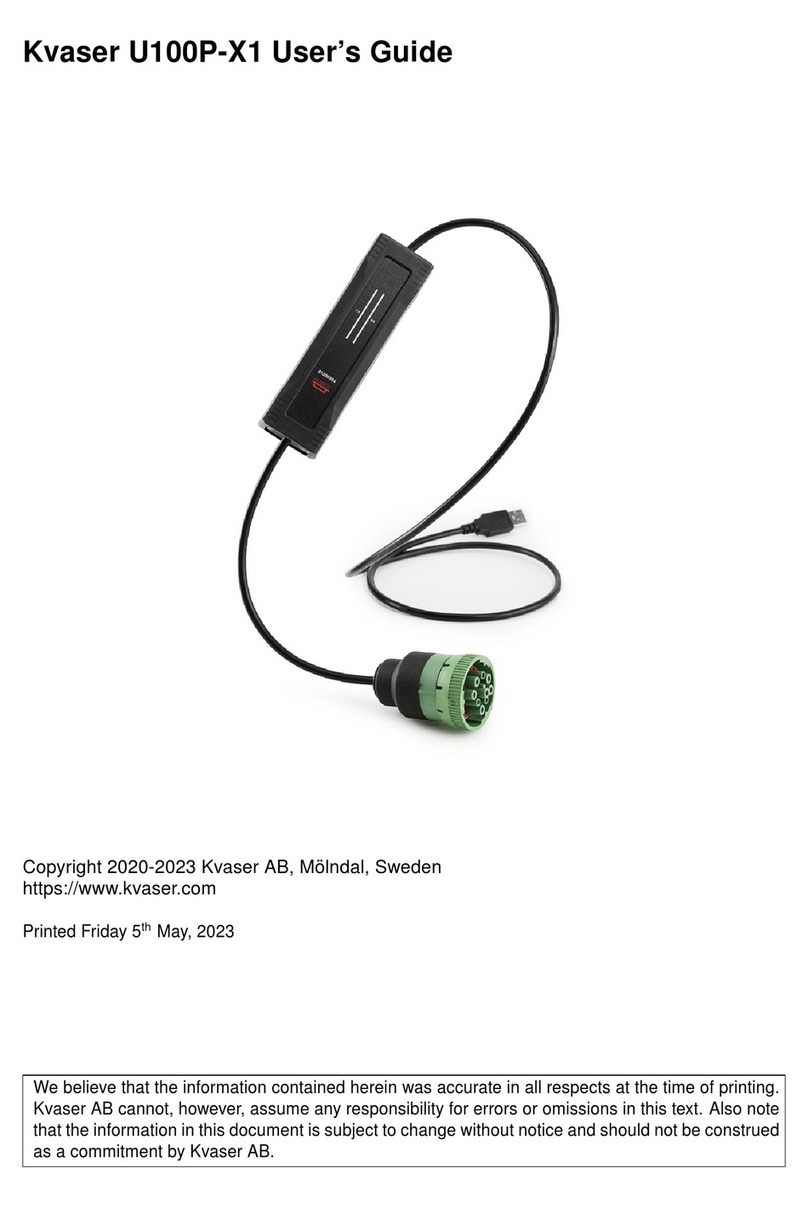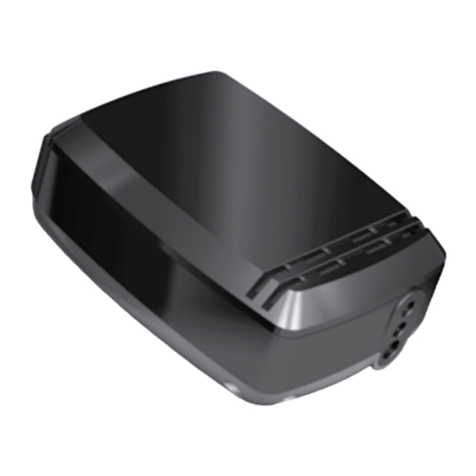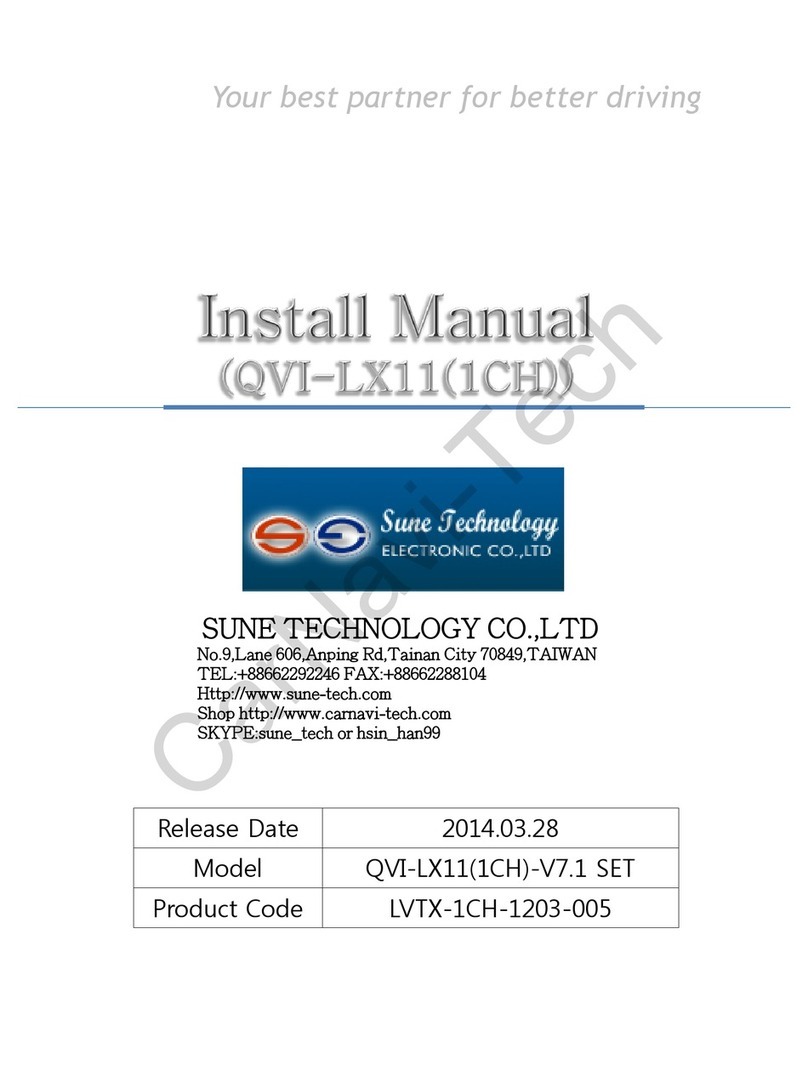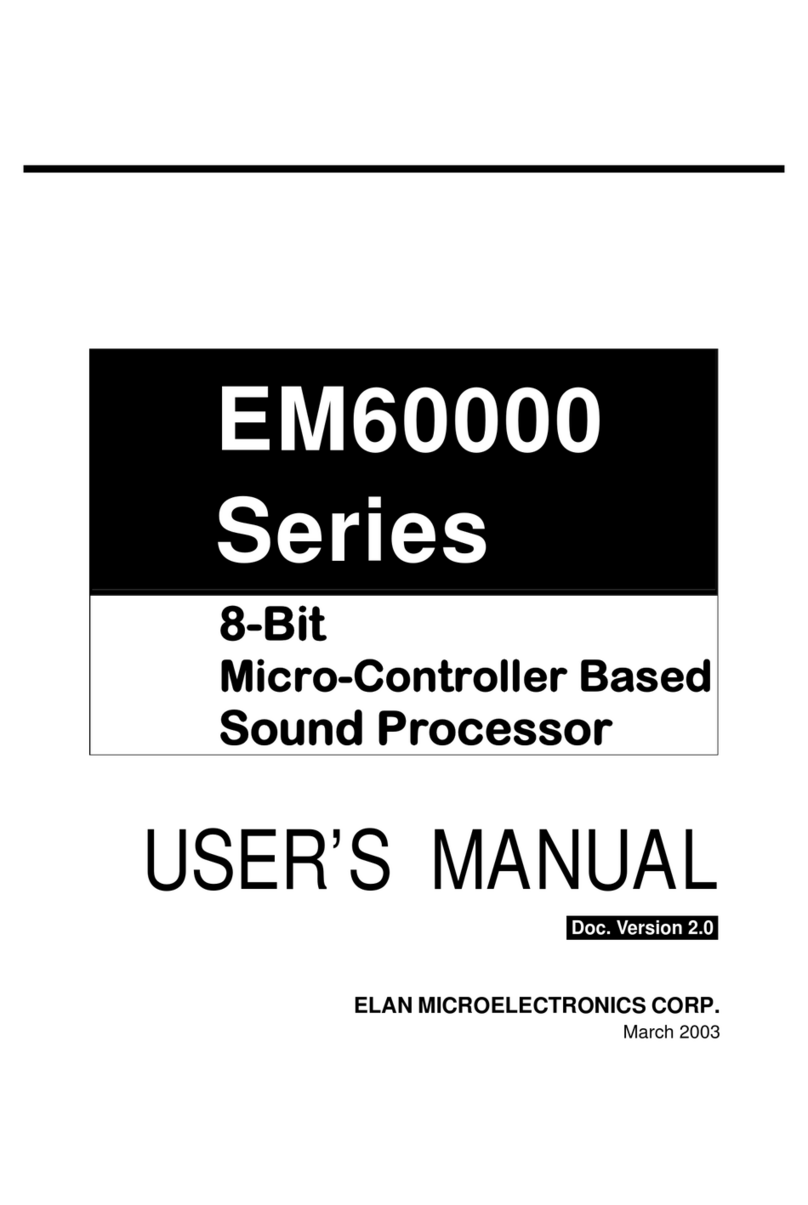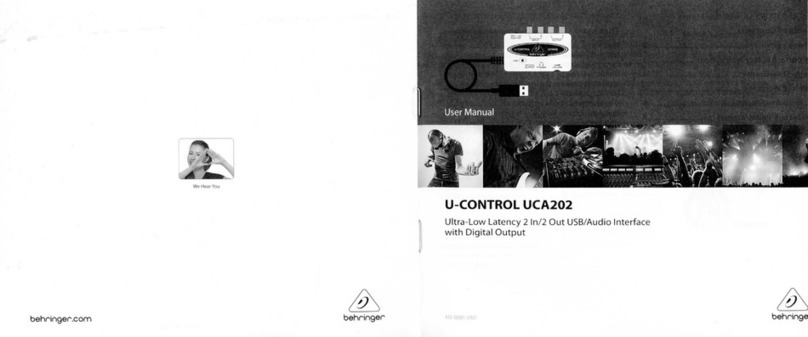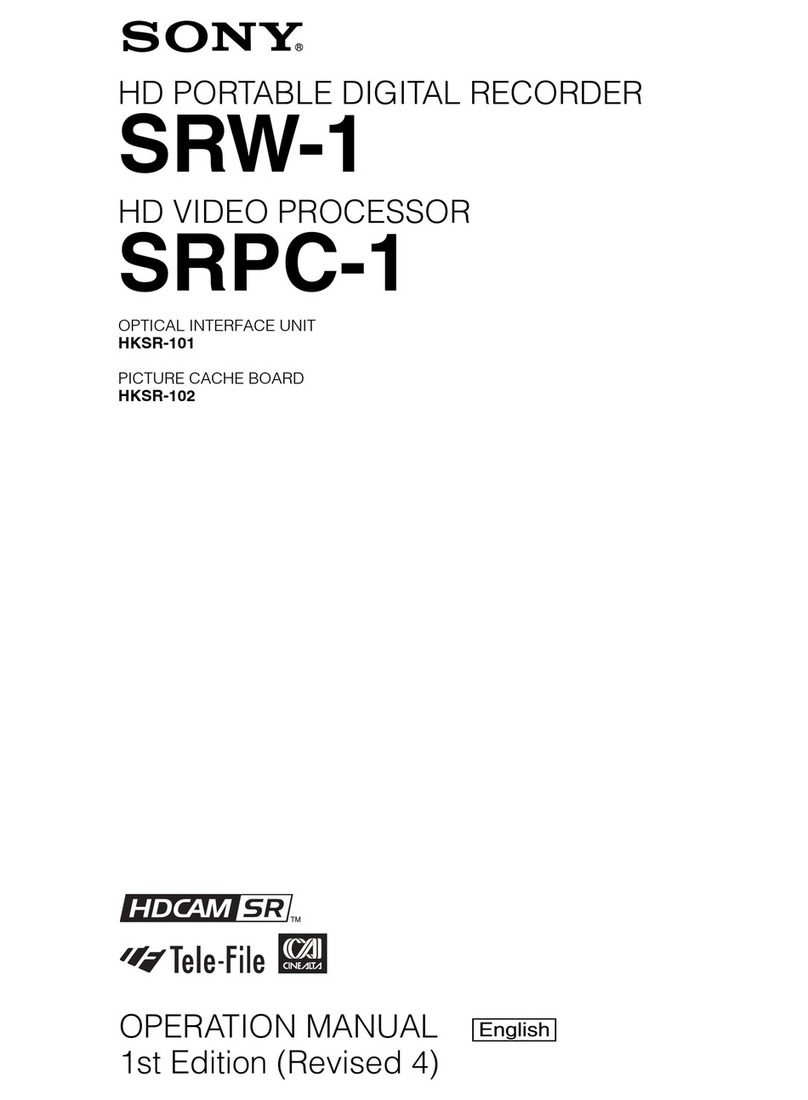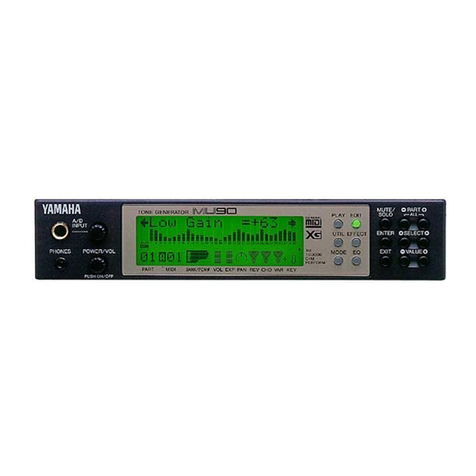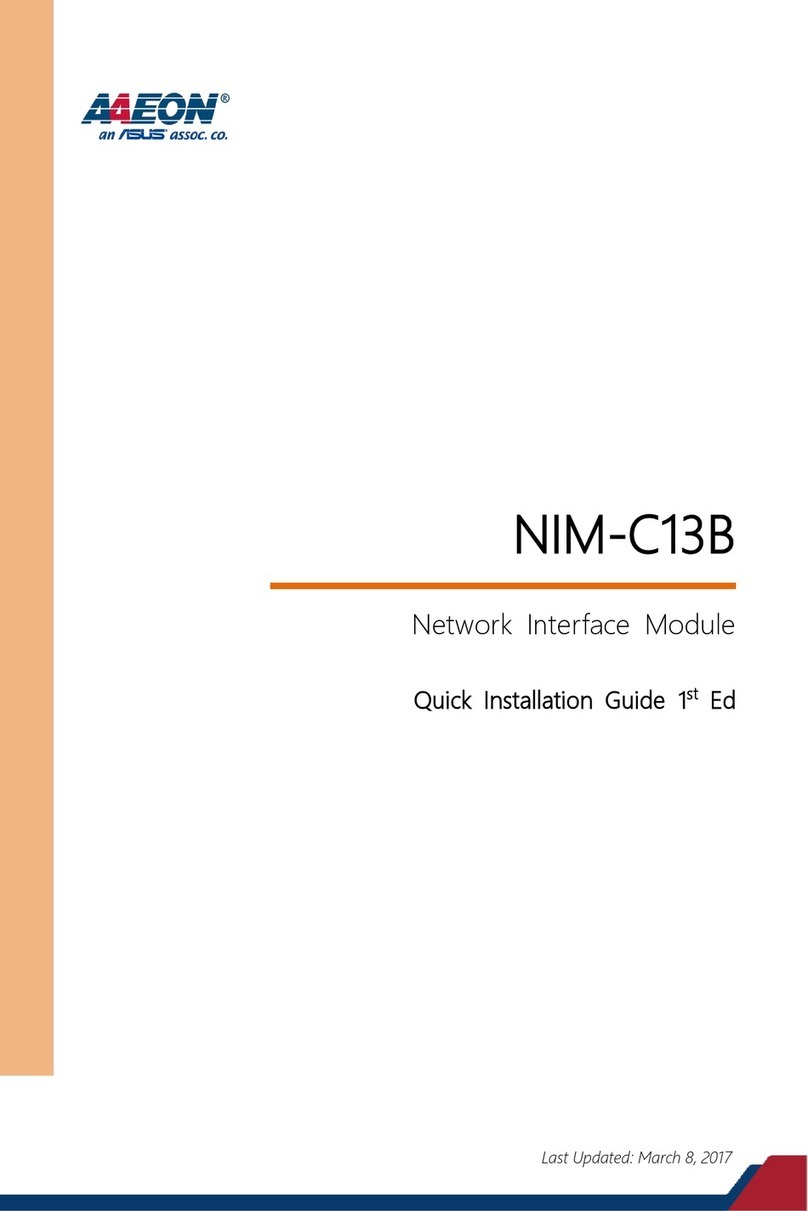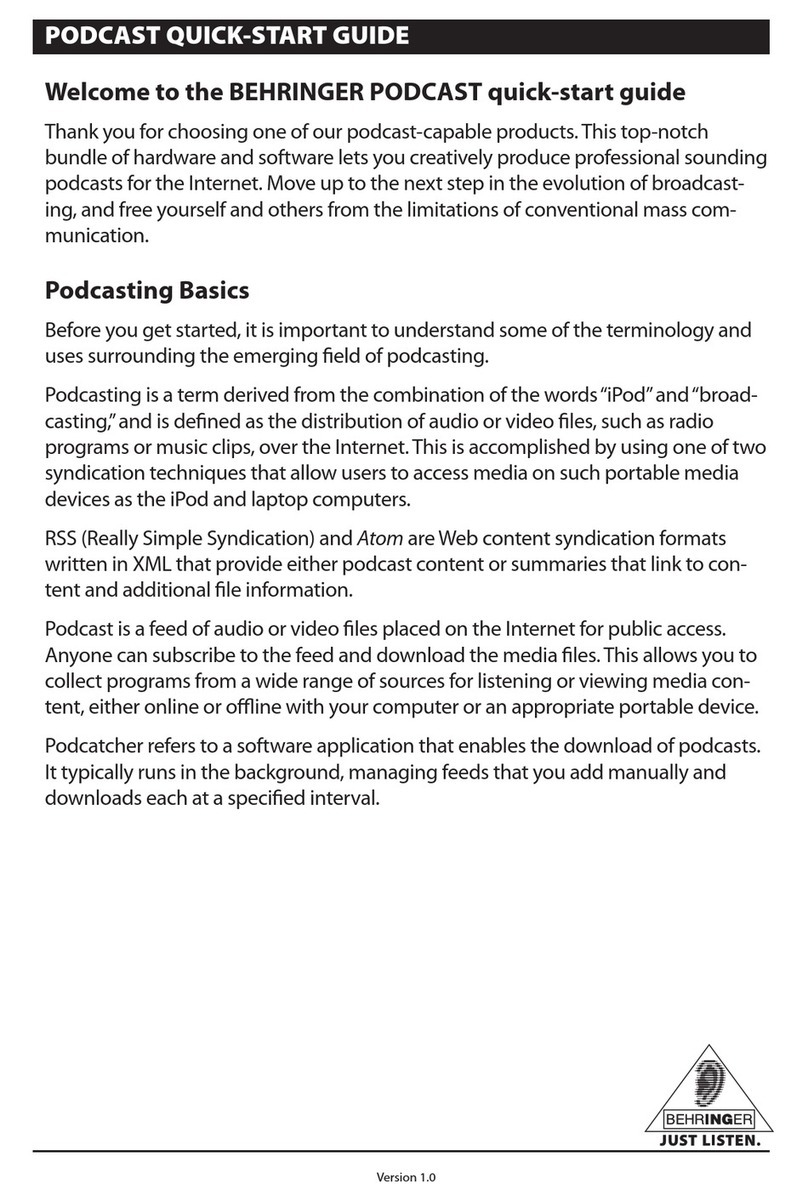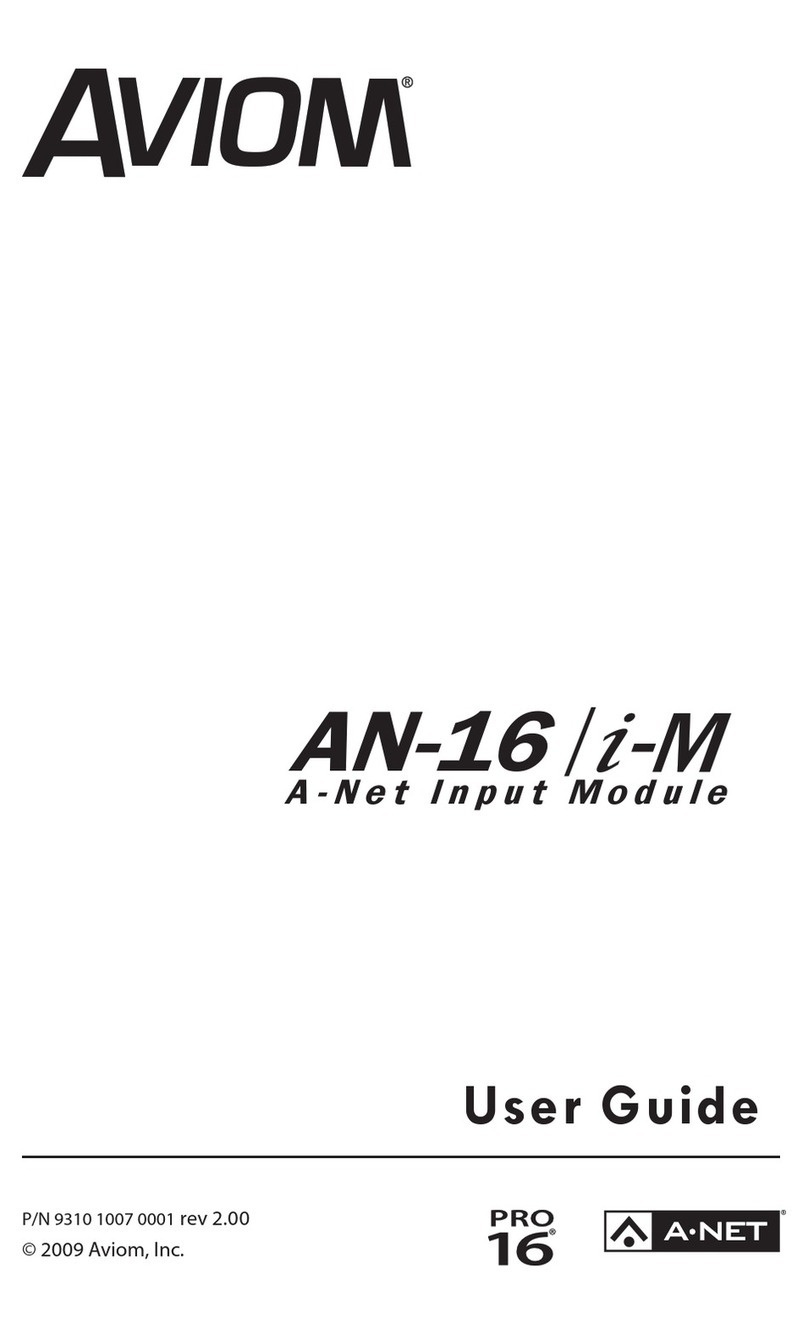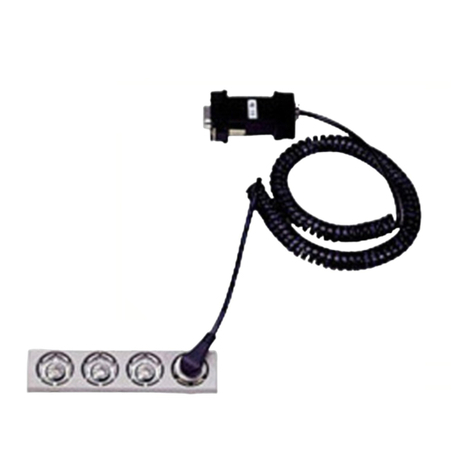Intellijel Palette 104 User manual

Palette Cases
4U Powered, Shallow Eurorack Cases
Manual (English)
Revision: 2020.11.30
Palette 104
104HP; MIDI IN/OUT; 3 Buff Mults, 2 Summers; 4 ¼” Audio Jacks
Palette 62
62 HP; MIDI IN; 2 Buff Mults; 2 ¼” Audio Jacks

COMPLIANCE
Palette Cases Manual 2
This device complies with Part 15 of the FCC Rules. Operation is subject to the
following two conditions: (1) this device may not cause harmful interference, and
(2) this device must accept any interference received, including interference that
may cause undesired operation.
Changes or modifications not expressly approved by Intellijel Designs, Inc. could
void the user’s authority to operate the equipment.
Any digital equipment has been tested and found to comply with the limits for a
Class A digital device, pursuant to part 15 of the FCC Rules. These limits are
designed to provide reasonable protection against harmful interference when the
equipment is operated in a commercial environment. This equipment generates,
uses, and can radiate radio frequency energy and, if not installed and used in
accordance with the instruction manual, may cause harmful interference to radio
communications.
This device meets the requirements of the following standards and directives:
EMC: 2014/30/EU
EN55032:2015 ; EN55103-2:2009 (EN55024) ; EN61000-3-2 ; EN61000-3-3
Low Voltage: 2014/35/EU
EN 60065:2002+A1:2006+A11:2008+A2:2010+A12:2011
RoHS2: 2011/65/EU
WEEE: 2012/19/EU

OVERVIEW
Intellijel’s Palette cases are compact enough to slip into a small bag, and shallow enough to rest
comfortably on a desktop — yet their capabilities far exceed their size. They’re available in two
widths: 62HP and 104HP, and each is as stylish as it is practical; as durable as it is portable; and
every bit as flexible as your imagination allows.
62HP Version
● 62HP of both 3U space (for standard eurorack modules), and 1U space (for all those necessary
little utility modules).
● Two built-in 1x4 buffered mults (chainable into a 1 x 8) with input level/polarity LEDs.
● Built-in MIDI Input (both USB and ⅛” TRS Type-A MIDI via the supplied 5-pin DIN adapter).
● Two ¼” TRS jacks, each of which can function as either an input or an output.
● Robust power circuit with 12 shrouded power connectors, and a 40W power brick capable of
supplying up to 1.2A of both +12V and -12V to your Eurorack modules.
● Two 5V connectors, delivering up to 500mA between them.
● Access connectors for internally connecting I/O modules to the built-in MIDI and Audio Jacks
● Link connector for connecting equipped modules (like Mixup and Pedal IO) directly into the ¼”
jacks.
104HP Version
● 104HP of both 3U space (for standard eurorack modules), and 1U space (for all those necessary
little utility modules).
● Three built-in 1x4 buffered mults (chainable into a 1 x 12) with input level/polarity LEDs.
● Two built-in 2-input summers (chainable with each other and with the Buff Mults).
● Built-in MIDI Input (both USB and ⅛” TRS Type-A MIDI via the supplied 5-pin DIN adapter).
● Built-in MIDI Out/Thru (via ⅛” TRS Type-A MIDI jack).
● Four ¼” TRS jacks, each of which can function as either an input or an output.
● Robust power circuit with 24 shrouded power connectors, and a 60W power brick capable of
supplying up to 1.5 amps of both +12V and -12V to your Eurorack modules.
● Two 5V connectors, delivering up to 500mA between them.
● Access connectors for internally connecting I/O modules to the built-in MIDI and Audio Jacks.
● Link connector for connecting equipped modules (like Mixup and Pedal IO) directly into the ¼”
jacks.
Palette Cases Manual 3

TOP PANEL
The following describe all Palette
Case features, though some are
not present on the 62HP version:
[1] Power Input Socket
Connect the included 15V
center-pin-positive power adapter
to this socket to provide power to
your case. The Palette 62 uses a
40W adapter, while the
Palette 104 uses a 60W adapter).
To ensure proper power is applied
to all your modules, use only
Intellijel certified power adapters.
[2] Power Switch
Switch to “I” to power up the
Palette, and all its connected modules. Switch to “0” to turn it off.
Palette Cases Manual 4

[3] MULT A
The first of two (62HP) or three (104HP) built-in 1 x 4 buffered signal multipliers. Plug an audio or
CV signal into the left-most jack and a buffered duplicate of that signal appears at the four jacks to
its right.
To the left of the MULT’s input jack is an LED, whose brightness indicates the amount of voltage
appearing at the input, and whose color indicates the polarity (with green signifying positive
voltages, and red signifying negative).
For more information about Buff Mults, see Understanding Buff Mults .
[4] MULT B
The second built-in 1 x 4 buffered signal multiplier. Plug an audio or CV signal into MULT B’s
left-most jack, and a buffered duplicate of that signal appears at the four jacks to its right.
MULT A is normalled to MULT B. So if nothing is plugged into MULT B’s input, then MULT A’s input
is duplicated across all 8 of MULT A & B’s outputs, making the two MULTS act as a single 1 x 8
buffered signal multiplier.
[5] MULT C (104HP Only)
Available only on the 104HP case, this is a third built-in 1 x 4 buffered signal multiplier. Plug an
audio or CV signal into MULT C’s left-most jack, and a buffered duplicate of that signal appears at
the four jacks to its right.
MULT B is normalled to MULT C. So if nothing is plugged into MULT C’s input, then MULT B’s input
is duplicated across all 8 of MULT B & C’s outputs. Also, if nothing is plugged into MULT B’s input,
then the signal appearing at MULT A’s input is duplicated across all 12 MULT outs.
[6] SUM A (104HP Only)
Available only on the 104HP case, this is a summing module that adds two voltages together. Plug
an audio or CV signal into SUM A’s left-most jack, and a second audio or CV signal into SUM A’s
other input jack, and a sum of the two signals appears at its output.
MULT C is normalled to the left-most input of SUM A. So if nothing is plugged into SUM A’s left-most
input, then the signal appearing at MULT C’s input is automatically sent into SUM A.
[7] SUM B (104HP Only)
Available only on the 104HP case, this is a second summing module that adds two voltages
together. Plug an audio or CV signal into SUM B’s left-most jack, and a second audio or CV signal
into SUM B’s other input jack, and a sum of the two signals appears at its output.
SUM A is normalled to the left-most input of SUM B. So if nothing is plugged into SUM B’s left-most
input, then the signal appearing at the output of SUM A is automatically sent into SUM B.
Palette Cases Manual 5

[8] TRS Audio Jacks
Each of these ¼” Neutrik TRS jacks can operate as either an audio input or an audio output
depending on which modules you connect to the circuit board inside the Palette case. This allows
you maximum flexibility when configuring your case — whether you wish to use these audio jacks
as outputs for a Palette-based synthesizer; as inputs for a Palette-based effects device; or as a
send/return for plugging external pedals or effects devices into your Palette’s signal chain.
These jacks may be used with many different modules (not included), such as the following:
●Stereo Line Out 1U : This module, when connected to an Audio Jacks Connector on the circuit
board , sends balanced +4dBu audio out a pair of ¼” TRS jacks. Use this module to send audio
from your Palette case to a mixer, amp, or DAW.
●Stereo Line In 1U : This module, when connected to an Audio Jacks Connector on the circuit
board , receives balanced +4dBu audio from a pair of ¼” TRS jacks. Use this module to receive
external audio for processing with other modules in your Palette case.
●Pedal I/O 1U : This module, when connected to the Link Connector on the circuit board ,
addresses a pair of ¼” TRS jacks — sending an unbalanced line-level output to the left jack,
and returning an unbalanced live-level input from the pair’s right jack. Use this module to patch
external effects or stomp boxes into your Palette.
●Mixup 3U : This module, when connected to the Link Connector on the circuit board , sends the
unbalanced L/R stereo mix from the rear-panel output of Mixup directly to a pair of ¼” jacks on
Palette. Alternatively, you can connect Mixup so that it receives unbalanced audio from a pair of
Palette’s ¼” jacks, instead.
●Stereo Mix 1U : This module, when connected to the Link Connector on the circuit board ,
sends the unbalanced L/R stereo mix from the rear-panel output of the Stereo Mix 1U directly to
a pair of ¼” jacks on Palette. Alternatively, you can connect Stereo Mix 1U so that it receives
unbalanced audio from a pair of Palette’s ¼” jacks, instead.
IMPORTANT : You should not attempt to connect multiple modules to a single pair of ¼” TRS jacks,
as unexpected results may occur.
NOTE: Palette Cases do not support Intellijel’s old Audio IO 1U module, and will not connect to it in
any way.
[9] ⅛” TRS MIDI Input
MIDI input connector on a ⅛” TRS (Type-A) jack. If you need to connect a 5-pin MIDI device, use
the included Type-A ⅛” TRS-to-5-pin MIDI adapter. MIDI arriving at this jack is routed to the 10-pin
MIDI Connector socket on the Palette’s circuit board , where it can be connected to a MIDI converter
module, such as the Intellijel MIDI 1U.
Palette Cases Manual 6

[10] ⅛” TRS MIDI Output (104HP Only)
MIDI output connector on a ⅛” TRS (Type-A) jack. When used with a MIDI 1U module, the jack
functions as a MIDI Thru — passing along any MIDI data received at the ⅛” TRS MIDI Input [9]
jack. If you need to connect a 5-pin MIDI device to this jack, you’ll need to purchase a standard
Type-A ⅛” TRS-to-5-pin MIDI adapter. Or connect it directly (no adapter required) to any other
device with a Type-A compatible TRS MIDI input (such as another Palette case, or any other device
that supports the MIDI 2.0 standard Type-A TRS connection).
[11] USB MIDI Input
MIDI input connector on USB. MIDI sent into the USB port is routed to the 10-pin MIDI Connector
socket on the Palette’s circuit board , where it can be connected to a MIDI input module, such as the
Intellijel MIDI 1U or the older µMIDI 1U.
[12] Mounting for 1U modules
Depending on which Palette Case you own, this area provides either 62HP or 104HP of mounting
space for Intellijel-format 1U modules.
[13] Mounting for 3U modules
Depending on which Palette Case you own, this area provides either 62HP or 104HP of mounting
space for eurorack standard 3U modules, up to a depth of 45.5mm. At each of the extreme edges
(occupying less than 1 hp) the depth is 37.42mm.
Palette Cases Manual 7

CIRCUIT BOARD
Running along the back edge of the Palette cases are their built-in circuit boards, which contain all of
Palette’s audio, midi, power, and module connection circuitry.
The jacks and switches that run along the top of the circuit board were discussed earlier in the Top
Panel description. Below these jacks and switches, and facing into the case, are the various headers
needed to connect your gear. These are:
Palette Cases Manual 8

[A] Power Connectors
These are the16-pin power connectors for powering your modules. The Palette 62 has 12
connectors, and the Palette 104 has 24. The connectors are shrouded to ensure that properly
manufactured ribbon cables can be connected only one way — with the red (-12V) wire to the right.
Make sure, if you’re using cables from another
manufacturer or sourced elsewhere, that the
red stripe is on the right when plugged in.
Plug the other end of the ribbon cables into
the Eurorack modules you wish to power —
being careful (if the module’s power connector
isn’t shrouded) to align the red stripe with the
-12V pins on the module. These pins are
indicated differently by different
manufacturers, but often will say “-12V,” or
“Red Stripe,” or have a visible white stripe
next to the -12V side of the connector. See your Eurorack modules for details concerning its -12V
power nomenclature.
[B] Audio Jacks Connector
These 6-pin connectors are for attaching either a balanced audio input or balanced audio output
module to the ¼” TRS connectors on the top of the Palette. The Palette 62 has one Audio Jacks
Connector (for its single pair of TRS jacks), while the Palette 104 has two Audio Jacks Connectors
(for its two pairs of TRS jacks). Some examples:
●Stereo Line Out 1U : Using the cable
provided with your Stereo Line
Out 1U module, connect it to the
Audio Jacks Connector (or to one of
the two Audio Jacks Connectors on
the 104HP case). Once connected,
the corresponding pair of Palette’s
TRS audio jacks function as L/R
audio outputs for the Palette case.
Palette Cases Manual 9

●Stereo Line In 1U : Using the cable
provided with your Stereo Line In 1U
module, connect it to the Audio Jacks
Connector (or to one of the two Audio
Jacks Connectors on the 104HP
case). Once connected, the
corresponding pair of Palette’s TRS
audio jacks function as L/R audio
inputs for the Palette case.
IMPORTANT : If you connect a module to the Audio Jacks Connector, you should not connect a
module to the same audio pair’s Link Connector (described later), or unexpected results may occur.
[C] MIDI Connector
Connect this 10-pin connector to your Intellijel MIDI 1U or µMIDI 1U modules using the cable
included with your MIDI module. This allows you to use the Pallete’s USB MIDI or ⅛” TRS MIDI
Jack(s) for connecting your eurorack system to standard MIDI gear.
Palette Cases Manual 10

[D] Link Connector
Use this 3-pin connector to attach either a Mixup module or a Pedal I/O module to the two ¼”
connectors on the top of the Palette.
●Mixup (OUT) : Connect the 3-wire link cable (provided with your Mixup module), between the
Link Connector on the Palette circuit board
and the CHAIN-OUT connector on your
Mixup.
In this scenario, unbalanced stereo audio
from Mixup’s output is sent out Palette’s two
corresponding Audio Jacks.
●Mixup (IN) : Connect the 3-wire link cable (provided with your Mixup module), between the Link
Connector on the Palette circuit board and the CHAIN-IN connector on your Mixup.
In this scenario, unbalanced stereo audio
arriving at the Palette’s corresponding pair
of Audio Jacks will be mixed with Mixup’s
own front panel inputs.
Palette Cases Manual 11

●Pedal I/O 1U : Connect the 3-wire link cable between the Link Connector on the Palette and the
one on your Pedal I/O.
In this scenario, unbalanced audio is sent
out Audio Jack 1 (or 3) to your external
signal processor, and unbalanced audio
comes back from your external signal
processor into Audio Jack 2 (or 4).
IMPORTANT : If you connect a module to the Links Connector, you should not connect a module to
the same audio pair’s Audio Jacks Connector (described previously), or unexpected results may
occur.
[E] 5V Connectors
Connect these 5V connectors to any modules that require a 5V power source. You can also use this
to power an Intellijel USB Power 1U module, which (for example) is useful for connecting a small
USB gooseneck LED light.
Palette Cases Manual 12

Connecting Two Audio Modules to the Palette104
Because the Palette 104 has two pairs of Audio Jacks, it’s possible to connect different devices to
each pair of jacks. For example, you could connect two Stereo Line Out 1U modules (one to each
6-pin Audio Connector) to have 4 audio outputs. Or you could connect a Stereo Line Out 1U module
to one 6-pin Audio Connector and a Stereo Line In 1U module to the other 6-pin Audio Connector to
have one pair of audio inputs and one pair of audio outputs.
You can mix and match
modules, as well. This
example combines a
Stereo Line Out 1U module
and a Pedal IO 1U module
giving you a pair of stereo
outputs, plus an effects
send/return loop.
Palette Cases Manual 13

INSTALLATION TIPS
Palette was designed to provide maximum performance and compatibility in the smallest possible
space. Because of this, and in accordance with those pesky little laws of physics, it can sometimes
be a little tedious to plug and unplug the various cables into the circuit board at the rear of the case.
Fortunately, there are a couple of things you can do to make the process quicker and easier:
● With the case completely empty, connect all of your power, link, 5V, 5-pin audio, and 10-pin MIDI
cables to the Palette circuit board first. If you think you might swap out modules in the future
(and, since this is Eurorack, you probably will), then it’s a good idea to connect a few more
power cables to the circuit board than you currently need — that will make it easier to add
additional modules in the future.
● The circuit board is much more accessible if you first remove the top rail. With the rail removed,
it’s much easier to plug the various connectors into the circuit board. To do this:
1. Remove the two screws (one on each side of the case) that hold the top rail in place.
Make note of the rail’s orientation, and set it aside.
2. Connect all the necessary cables to the circuit board.
3. Slide the rail back into place, and re-insert the screws on either side.
4. Connect the cables to all your modules and screw them into the rails.
Palette Cases Manual 14

UNDERSTANDING BUFF MULTS
“Buff Mult” is vernacular shorthand for “Buffered Multiplier.” A buff mult takes a single input signal
and routes it to multiple outputs simultaneously. For example, you might want to route a keyboard’s
pitch CV to three different destinations: one to govern the pitch of your main oscillator; another to
govern the pitch of a second oscillator; and the third to open and close a filter so that it tracks across
the keyboard.
Unlike a passive mult, which merely splits the incoming signal and shares it across multiple outputs
(much like a Y-cable), buffered mults make electrical copies of an input voltage and duplicate that
voltage at the outputs.
Buffered mults have a few advantages over passive mults. Because buffered mults isolate their
outputs from the input, any faults or shorts present at the input will not pass through to a connected
module. Also, in a passive mult, what you connect to an output can cause a slight variation in the
voltages that it sends. In some situations (like an LFO or envelope), this probably won’t have any
sonic effect on your patch. But for voltage-critical functions (like an oscillator, where only a slight
change in voltage is easily heard), it’s often better to use a buffered mult, since this insures that the
1V/Oct signal arriving at its input will be electrically and accurately duplicated across all its outputs.
Your Palette 62 has two Buff Mults, and your Palette 104 has three. Each is a stand-alone
1 IN x 4 OUT buffered multiplier. Plug an audio or CV signal into MULT A’s input jack, and a buffered
duplicate of that signal is sent out the four jacks to its right. Similarly, an audio or CV signal patched
into MULT B’s input jack is duplicated at the other four jacks in the group.
The input of each MULT is normalled to the previous. So if nothing is plugged into MULT B’s input
jack, then the input to MULT A is multiplied and sent to eight outputs (four from MULT A and four
from MULT B), giving you a single 1 x 8 buffered signal multiplier. Similarly, on the Palette 104, if
nothing is plugged into either MULT B or MULT C’s input jacks, then the input to MULT A is multiplied
and sent to all twelve outputs.
Palette Cases Manual 15

TECHNICAL SPECIFICATIONS
Palette62
Palette104
Palette Cases Manual 16
Dimensions
324.4 x 204.4 x 51.3 (mm)
(58.5 mm high, when including rubber feet/jacks)
12.77” x 8.05” x 2.02”
(2.3” high, when including rubber feet/jacks)
62 hp for 3U modules + 62 hp for 1U modules
Maximum Module Depth
45.5 mm for middle 60HP
37.42mm at each 1HP edge
Current Supplied
1.2A @ 12V
1.2A @ -12V
500mA @ +5V
40W Power Brick
Dimensions
537.7 x 204.4 x 51.3 (mm)
(58.5 mm high, when including rubber feet/jacks)
21.17” x 8.05” x 2.02”
(2.3” high, when including rubber feet/jacks)
104 hp for 3U modules + 104 hp for 1U modules
Maximum Module Depth
45.5 mm for middle 102HP
37.42 mm at each 1HP edge
Current Supplied
1.5 A @ 12V
1.5 A @ -12V
500 mA @ +5V
60W Power Brick
This manual suits for next models
1
Table of contents
Other Intellijel Recording Equipment manuals
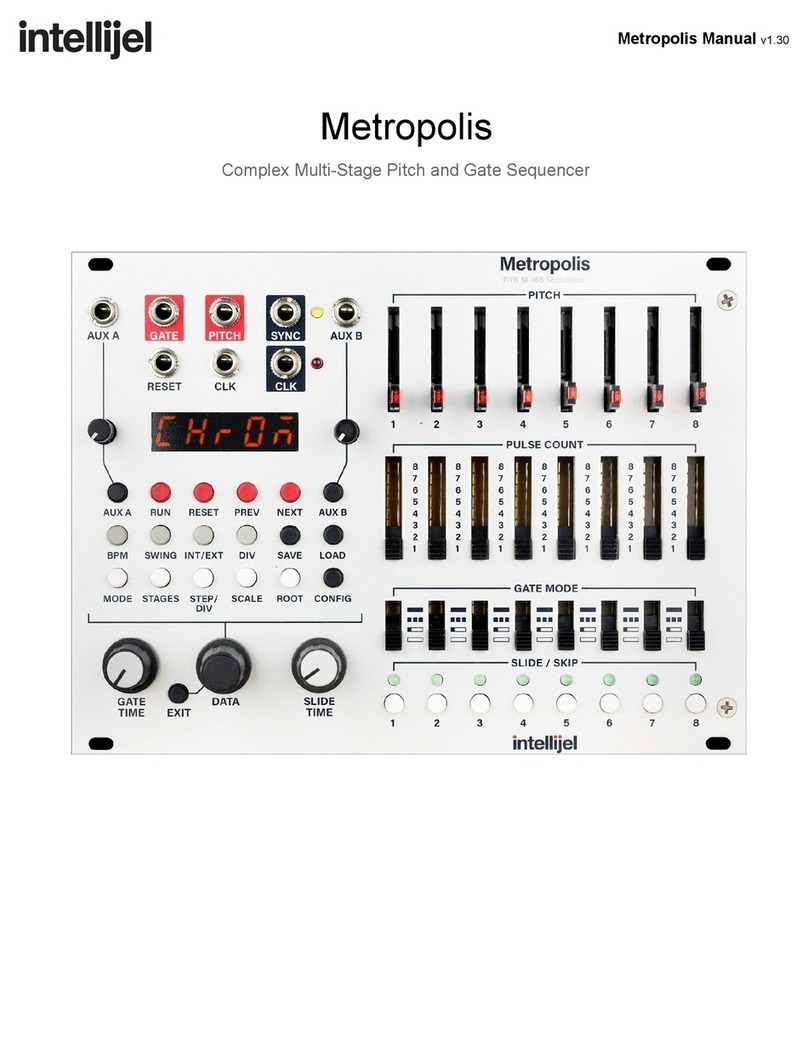
Intellijel
Intellijel Metropolis User manual
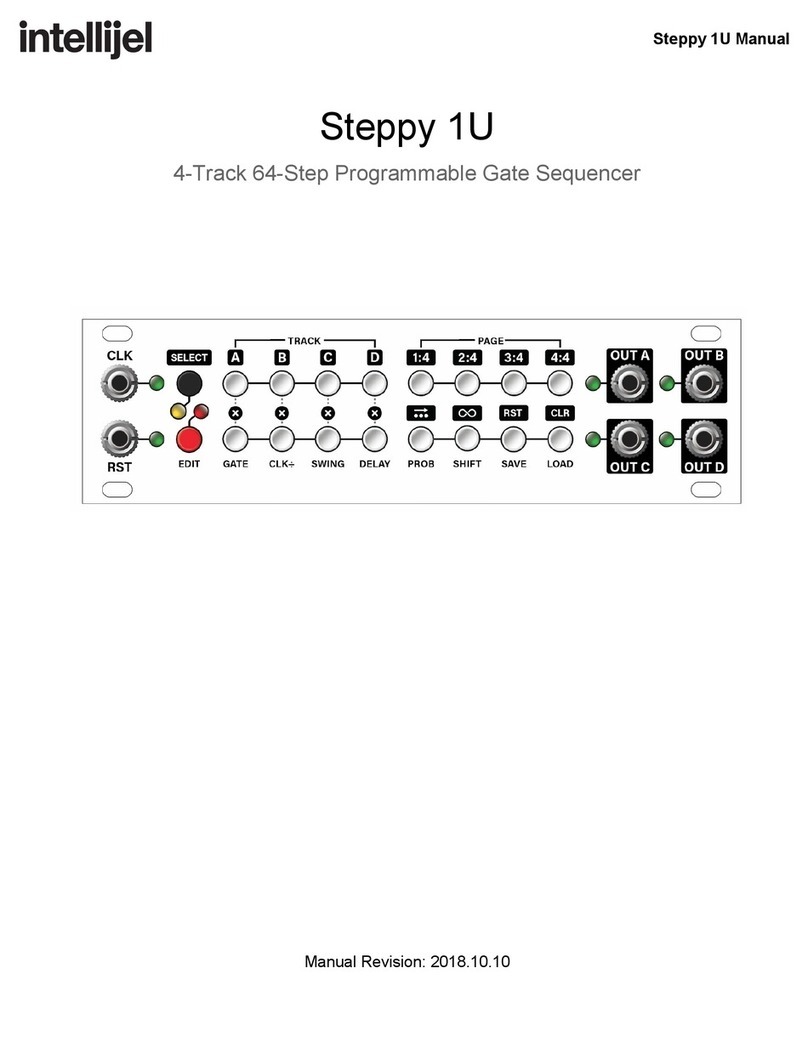
Intellijel
Intellijel Steppy 1U User manual
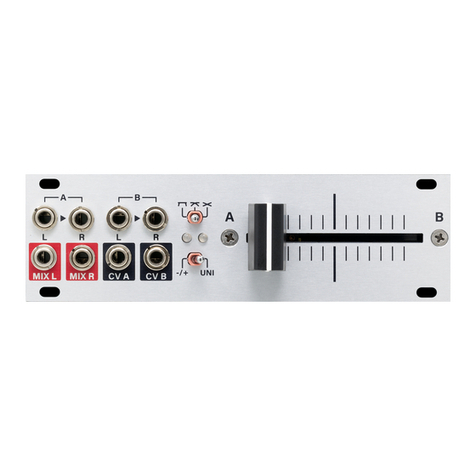
Intellijel
Intellijel XFADE 1U User manual

Intellijel
Intellijel Passive LPG 1U User manual
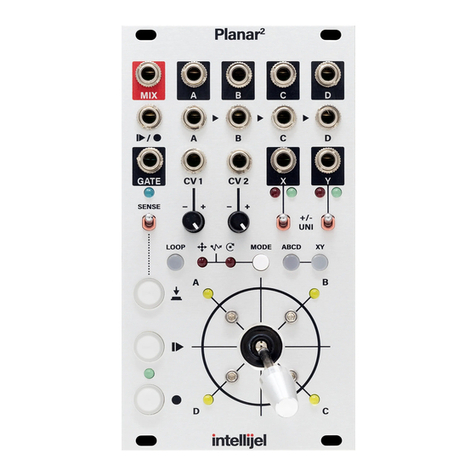
Intellijel
Intellijel Planar2 User manual
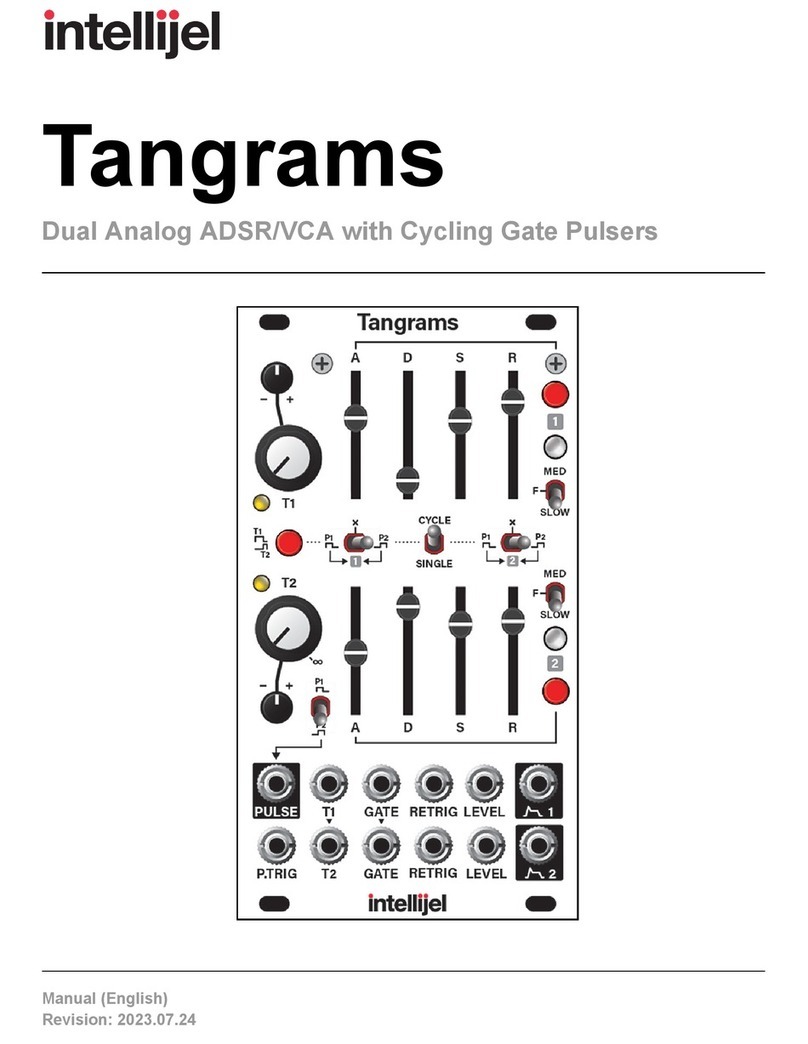
Intellijel
Intellijel Tangrams User manual

Intellijel
Intellijel Quadrax User manual
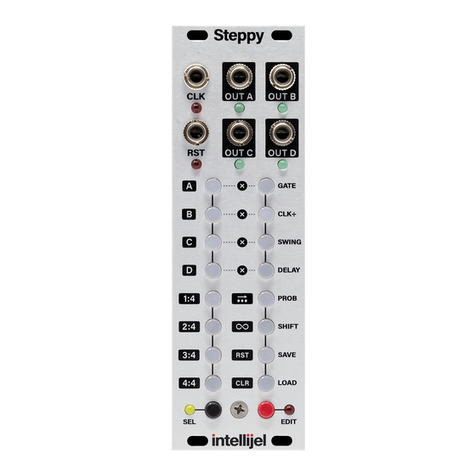
Intellijel
Intellijel Steppy 3U User manual
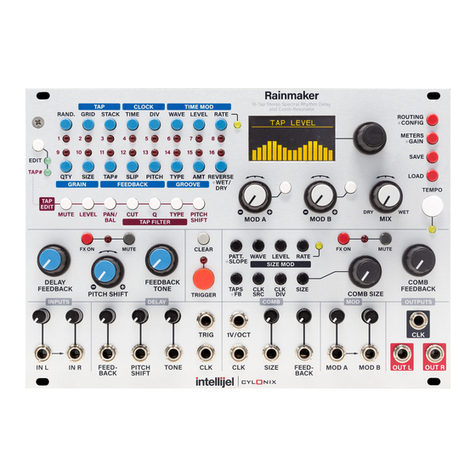
Intellijel
Intellijel CYLONYX Rainmaker User manual

Intellijel
Intellijel Steppy 3U User manual



